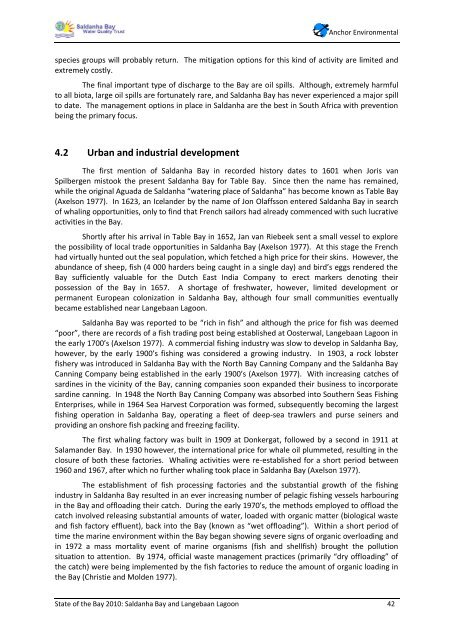State of the Bay Report 2010-Final - Anchor Environmental
State of the Bay Report 2010-Final - Anchor Environmental
State of the Bay Report 2010-Final - Anchor Environmental
You also want an ePaper? Increase the reach of your titles
YUMPU automatically turns print PDFs into web optimized ePapers that Google loves.
<strong>Anchor</strong> <strong>Environmental</strong><br />
species groups will probably return. The mitigation options for this kind <strong>of</strong> activity are limited and<br />
extremely costly.<br />
The final important type <strong>of</strong> discharge to <strong>the</strong> <strong>Bay</strong> are oil spills. Although, extremely harmful<br />
to all biota, large oil spills are fortunately rare, and Saldanha <strong>Bay</strong> has never experienced a major spill<br />
to date. The management options in place in Saldanha are <strong>the</strong> best in South Africa with prevention<br />
being <strong>the</strong> primary focus.<br />
4.2 Urban and industrial development<br />
The first mention <strong>of</strong> Saldanha <strong>Bay</strong> in recorded history dates to 1601 when Joris van<br />
Spilbergen mistook <strong>the</strong> present Saldanha <strong>Bay</strong> for Table <strong>Bay</strong>. Since <strong>the</strong>n <strong>the</strong> name has remained,<br />
while <strong>the</strong> original Aguada de Saldanha “watering place <strong>of</strong> Saldanha” has become known as Table <strong>Bay</strong><br />
(Axelson 1977). In 1623, an Icelander by <strong>the</strong> name <strong>of</strong> Jon Olaffsson entered Saldanha <strong>Bay</strong> in search<br />
<strong>of</strong> whaling opportunities, only to find that French sailors had already commenced with such lucrative<br />
activities in <strong>the</strong> <strong>Bay</strong>.<br />
Shortly after his arrival in Table <strong>Bay</strong> in 1652, Jan van Riebeek sent a small vessel to explore<br />
<strong>the</strong> possibility <strong>of</strong> local trade opportunities in Saldanha <strong>Bay</strong> (Axelson 1977). At this stage <strong>the</strong> French<br />
had virtually hunted out <strong>the</strong> seal population, which fetched a high price for <strong>the</strong>ir skins. However, <strong>the</strong><br />
abundance <strong>of</strong> sheep, fish (4 000 harders being caught in a single day) and bird’s eggs rendered <strong>the</strong><br />
<strong>Bay</strong> sufficiently valuable for <strong>the</strong> Dutch East India Company to erect markers denoting <strong>the</strong>ir<br />
possession <strong>of</strong> <strong>the</strong> <strong>Bay</strong> in 1657. A shortage <strong>of</strong> freshwater, however, limited development or<br />
permanent European colonization in Saldanha <strong>Bay</strong>, although four small communities eventually<br />
became established near Langebaan Lagoon.<br />
Saldanha <strong>Bay</strong> was reported to be “rich in fish” and although <strong>the</strong> price for fish was deemed<br />
“poor”, <strong>the</strong>re are records <strong>of</strong> a fish trading post being established at Oosterwal, Langebaan Lagoon in<br />
<strong>the</strong> early 1700’s (Axelson 1977). A commercial fishing industry was slow to develop in Saldanha <strong>Bay</strong>,<br />
however, by <strong>the</strong> early 1900’s fishing was considered a growing industry. In 1903, a rock lobster<br />
fishery was introduced in Saldanha <strong>Bay</strong> with <strong>the</strong> North <strong>Bay</strong> Canning Company and <strong>the</strong> Saldanha <strong>Bay</strong><br />
Canning Company being established in <strong>the</strong> early 1900’s (Axelson 1977). With increasing catches <strong>of</strong><br />
sardines in <strong>the</strong> vicinity <strong>of</strong> <strong>the</strong> <strong>Bay</strong>, canning companies soon expanded <strong>the</strong>ir business to incorporate<br />
sardine canning. In 1948 <strong>the</strong> North <strong>Bay</strong> Canning Company was absorbed into Sou<strong>the</strong>rn Seas Fishing<br />
Enterprises, while in 1964 Sea Harvest Corporation was formed, subsequently becoming <strong>the</strong> largest<br />
fishing operation in Saldanha <strong>Bay</strong>, operating a fleet <strong>of</strong> deep-sea trawlers and purse seiners and<br />
providing an onshore fish packing and freezing facility.<br />
The first whaling factory was built in 1909 at Donkergat, followed by a second in 1911 at<br />
Salamander <strong>Bay</strong>. In 1930 however, <strong>the</strong> international price for whale oil plummeted, resulting in <strong>the</strong><br />
closure <strong>of</strong> both <strong>the</strong>se factories. Whaling activities were re-established for a short period between<br />
1960 and 1967, after which no fur<strong>the</strong>r whaling took place in Saldanha <strong>Bay</strong> (Axelson 1977).<br />
The establishment <strong>of</strong> fish processing factories and <strong>the</strong> substantial growth <strong>of</strong> <strong>the</strong> fishing<br />
industry in Saldanha <strong>Bay</strong> resulted in an ever increasing number <strong>of</strong> pelagic fishing vessels harbouring<br />
in <strong>the</strong> <strong>Bay</strong> and <strong>of</strong>floading <strong>the</strong>ir catch. During <strong>the</strong> early 1970’s, <strong>the</strong> methods employed to <strong>of</strong>fload <strong>the</strong><br />
catch involved releasing substantial amounts <strong>of</strong> water, loaded with organic matter (biological waste<br />
and fish factory effluent), back into <strong>the</strong> <strong>Bay</strong> (known as “wet <strong>of</strong>floading”). Within a short period <strong>of</strong><br />
time <strong>the</strong> marine environment within <strong>the</strong> <strong>Bay</strong> began showing severe signs <strong>of</strong> organic overloading and<br />
in 1972 a mass mortality event <strong>of</strong> marine organisms (fish and shellfish) brought <strong>the</strong> pollution<br />
situation to attention. By 1974, <strong>of</strong>ficial waste management practices (primarily “dry <strong>of</strong>floading” <strong>of</strong><br />
<strong>the</strong> catch) were being implemented by <strong>the</strong> fish factories to reduce <strong>the</strong> amount <strong>of</strong> organic loading in<br />
<strong>the</strong> <strong>Bay</strong> (Christie and Molden 1977).<br />
<strong>State</strong> <strong>of</strong> <strong>the</strong> <strong>Bay</strong> <strong>2010</strong>: Saldanha <strong>Bay</strong> and Langebaan Lagoon 42

















